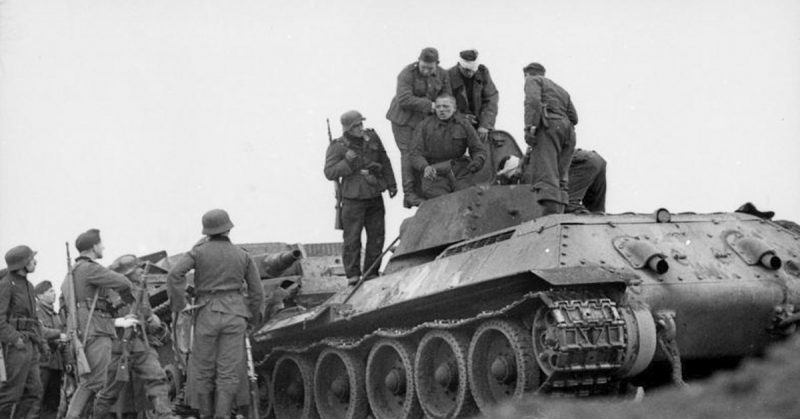A quick look at the invasion of the Soviet Union by Nazi Germany in 33 facts
1.The invasion of the Soviet Union was the most ambitious campaign of the Second World War, and yet Hitler believed that it could be won within three months with a fast, powerful blitzkrieg strike.
2. The campaign was launched with Fuhrer Directive 21. Signed on 18 December 1940, it set out the intention to “crush Soviet Russia in one rapid campaign”.
3. In February 1941, British and American intelligence learned of the planned invasion of the USSR. Hoping to encourage Stalin to act against Hitler, they informed him of the plan. Stalin did not believe them, as he believed that Hitler would stick to the non-aggression pact the two countries had signed before the war.
4. The German navy was to play a part in the operation, blocking Soviet ships from breaking out of the Baltic Sea.
5. Ready for the invasion, the Germans mustered over 3 million soldiers in 152 divisions. This included 17 Panzer and 13 motorized divisions.
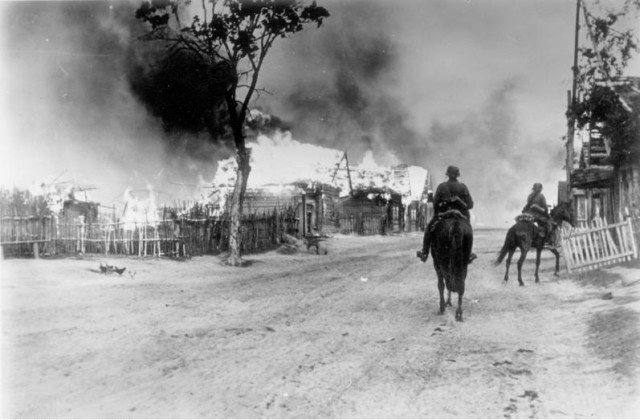
6. Transport was provided by 625,000 horses and 600,000 motor vehicles.
7. The initial invasion force included 3,350 tanks, 7,146 artillery pieces, and 1,950 aircraft.
8. The Finnish army also took part in the invasion. They supplied 17 divisions and 2 brigades. Following the Soviet invasion of Finland earlier in the war, they were eager for revenge.
9. Romania also contributed to the army, with 14 divisions, 7 brigades and one reinforced panzer regiment.
10. The German ambassador in Moscow delivered a declaration of war at 0530 on 22 June 1941, citing Soviet violations of their pact as the excuse for invasion.
11. The frontier across which the Germans invaded ran from the Baltic to the Black Sea, a distance of 1,900 miles.
12. They were divided into three army groups – Army Group South under Field Marshal Gerd von Rundstedt, Army Group North under Field Marshal Wilhelm von Leeb, and Army Group Centre under Field Marshal Fedor von Bock.
13. The invasion was named Operation Barbarossa after the founder of the 12th century First German Reich.
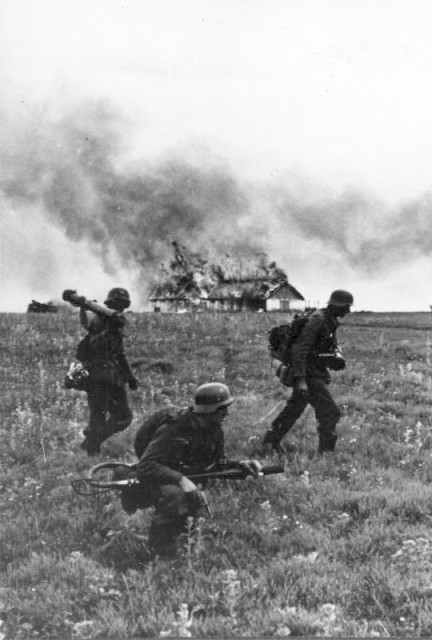
14. Only 20% of the invading forces could conduct the sort of rapid mobile warfare Operation Barbarossa relied on – the rest were too slow-moving to keep up with the rapid pace of blitzkrieg.
15. Stalin was so shocked by the invasion that it was said he did not speak for eleven days.
16. The Soviets had two to three times as many tanks and planes as the Germans, but many of the planes were obsolete.
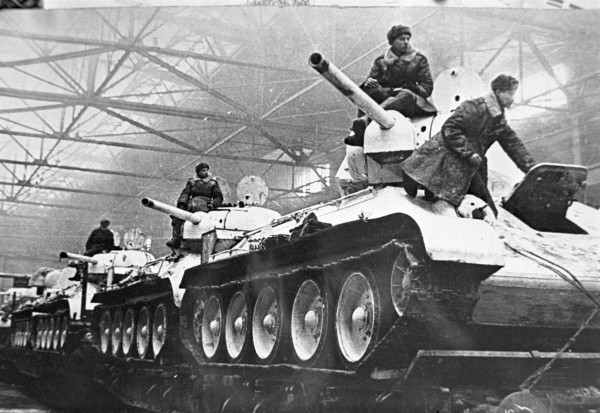
By RIA Novosti archive, image #1274 / RIA Novosti / CC-BY-SA 3.0, CC BY-SA 3.0,
17. Among the Russian tanks was the T-34, arguably the best tank of any fielded in the Second World War.
18. At the time of the invasion, the Soviets had 150 divisions in their western territory, able to immediately turn and face the Germans.
19. After two weeks, successful battles on the frontiers led the Nazi command to believe that the campaign was already won, the Soviet forces crumbling.
20. The speedy initial advance allowed the Germans to take in the summer harvest from most of Ukraine, bolstering their food supply and badly depriving the Soviets.
21. The Germans surrounded several Soviet armies, forcing them to surrender. Those cut off at Minsk and Smolensk alone led to nearly 600,000 soldiers becoming prisoners of war. A further 665,000 prisoners were taken at Kiev.
22. By the end of July, just over a month into the invasion, they had seized a chunk of the Soviet Union over twice the size of France.
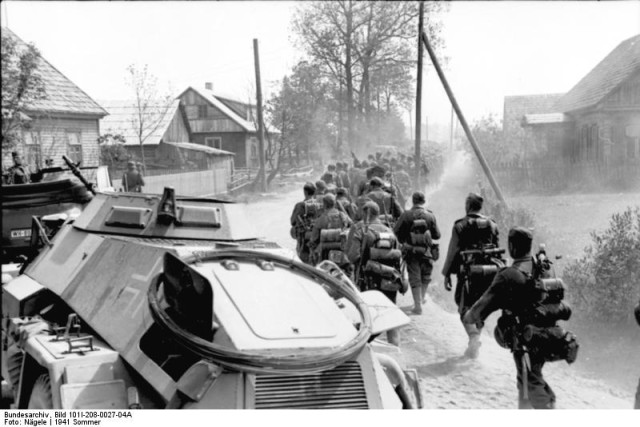
23. By mid-August, 200 more Soviet divisions had joined the fray, massively outnumbering the Germans.
24. The Soviets struggled with military leadership, as Stalin had purged the Red Army in the 1930s, getting rid of supposedly anti-Communist officers, and killing many of the best generals in the process.
25. In the Baltic states and parts of Belorussia and Ukraine, the Germans were welcomed as liberators throwing out the Russian Communist oppressors.
26. In Kiev, the Jews welcomed the Nazis. The Germans had treated Kiev’s Jews well during the First World War, and the horrors of the death camps had not yet been revealed. But a terrible shock followed within days, as 100,000 Jews were led out of the city and massacred at the Baby Yar ravine.
27. To keep the war effort going, Stalin had entire factories moved eastwards so that they could keep on manufacturing aircraft, tanks, and other equipment.
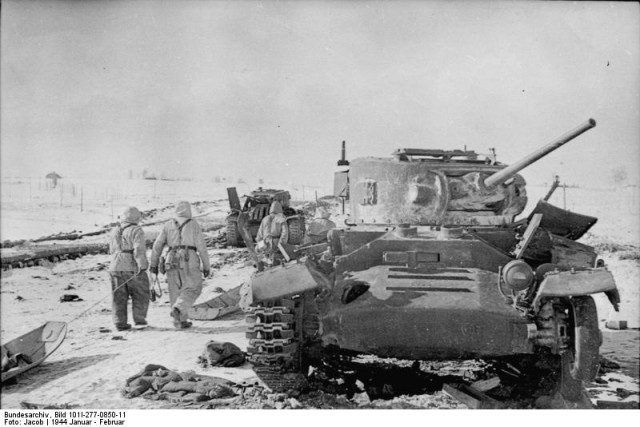
By Bundesarchiv, Bild 101I-277-0850-11 / Jacob / CC-BY-SA 3.0
28. Eager to keep Hitler occupied in the east, Britain and America both quickly began providing the Soviets with materials. They helped to build up the military machine that they, in turn, would face off against a decade later – a recurring theme in 20th-century wars.
29. From 10 July to 16 August, the Finnish army re-took the land they had lost to the Soviets. The German-Soviet Molotov-Ribbentrop Pact had enabled these Soviet conquests, but it was the Germans whose invasion allowed the Finns to retake their lost territory. They stopped at the old border, refusing to join the Germans in their invasion of Russia, but their presence helped to cut off Leningrad from the north.
30. The Siege of Leningrad, one of the most important engagements of the invasion, lasted 900 days. During that time, 200,000 civilians were killed by German bombardment. At least another 630,000 died from the disease and starvation that are constant threats for the targets of any siege.
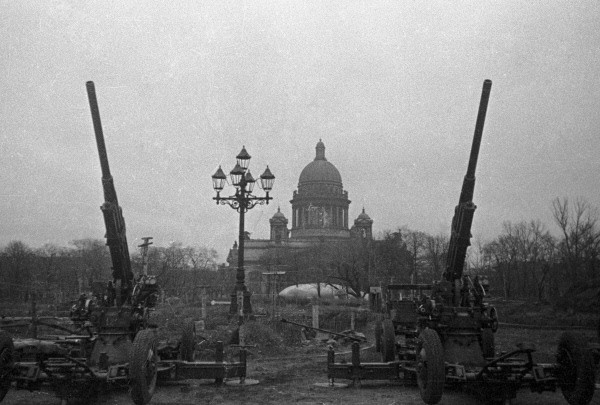
31. With the fall of Vyazma and Bryansk in October, the Russians were left with only 824 tanks and no air support on the front.
32. When foreign diplomats were evacuated from Moscow in preparation for a siege, the embalmed body of former Soviet leader Lenin went with them. His loss was considered too terrible a propaganda blow for the Soviets to risk leaving him there.
33. The winter that halted the German advance was the coldest for 140 years. Oil froze in the engines of tanks. The grease used to pack artillery froze. Almost everyone in the German army suffered from frostbite. The same problems that had stopped the Soviets in Finland now saved them.
